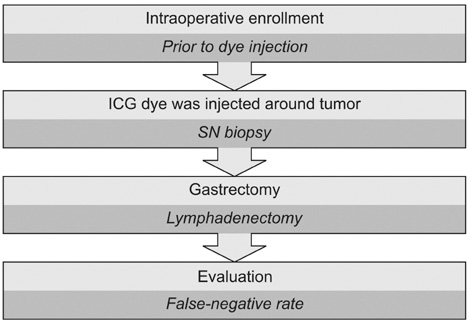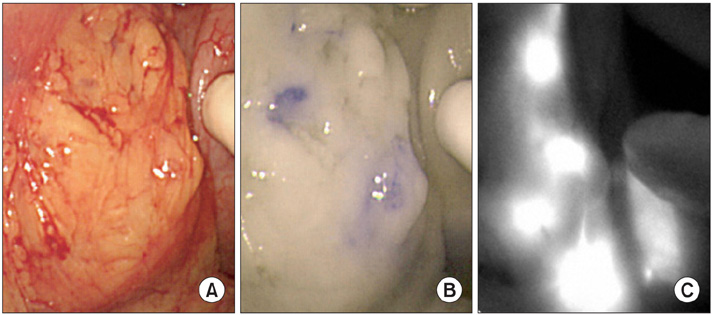J Gastric Cancer.
2012 Mar;12(1):7-12.
What Is the Problem in Clinical Application of Sentinel Node Concept to Gastric Cancer Surgery?
- Affiliations
-
- 1Department of Surgery, Osaka Medical Center for Cancer and Cardiovascular Diseases, Osaka, Japan. miyashir@biken.osaka-u.ac.jp
Abstract
- More than ten years have passed since the sentinel node (SN) concept for gastric cancer surgery was first discussed. Less invasive modified surgical approaches based on the SN concept have already been put into practice for malignant melanoma and breast cancer, however the SN concept is not yet placed in a standard position in gastric cancer surgery even after two multi-institutional prospective clinical trials, the Japan Clinical Oncology Group trial (JCOG0302) and the Japanese Society for Sentinel Node Navigation Surgery (SNNS) trial. What is the problem in the clinical application of the SN concept to gastric cancer surgery? There is no doubt that we need reliable indicator(s) to determine with certainty the absence of metastasis in the lymph nodes in order to avoid unnecessary lymphadenectomy. There are several matters of debate in performing the actual procedure, such as the type of tracer, the site of injection, how to detect and harvest, how to detect metastases of SNs, and learning period. These issues have to be addressed further to establish the most suitable procedure. Novel technologies such as indocyanine green (ICG) fluorescence imaging and one-step nucleic acid amplification (OSNA) may overcome the current difficulties. Once we know what the problems are and how to tackle them, we can pursue the goal.
Keyword
MeSH Terms
Figure
Reference
-
1. Kitagawa Y, Fujii H, Mukai M, Kubota T, Ando N, Watanabe M, et al. The role of the sentinel lymph node in gastrointestinal cancer. Surg Clin North Am. 2000. 80:1799–1809.
Article2. Hiratsuka M, Miyashiro I, Ishikawa O, Furukawa H, Motomura K, Ohigashi H, et al. Application of sentinel node biopsy to gastric cancer surgery. Surgery. 2001. 129:335–340.
Article3. Morton DL, Wen DR, Wong JH, Economou JS, Cagle LA, Storm FK, et al. Technical details of intraoperative lymphatic mapping for early stage melanoma. Arch Surg. 1992. 127:392–399.
Article4. Krag DN, Weaver DL, Alex JC, Fairbank JT. Surgical resection and radiolocalization of the sentinel lymph node in breast cancer using a gamma probe. Surg Oncol. 1993. 2:335–339.
Article5. Giuliano AE, Kirgan DM, Guenther JM, Morton DL. Lymphatic mapping and sentinel lymphadenectomy for breast cancer. Ann Surg. 1994. 220:391–398.
Article6. Bostick P, Essner R, Glass E, Kelley M, Sarantou T, Foshag LJ, et al. Comparison of blue dye and probe-assisted intraoperative lymphatic mapping in melanoma to identify sentinel nodes in 100 lymphatic basins. Arch Surg. 1999. 134:43–49.
Article7. Giuliano AE, Jones RC, Brennan M, Statman R. Sentinel lymphadenectomy in breast cancer. J Clin Oncol. 1997. 15:2345–2350.
Article8. Lips DJ, Schutte HW, van der Linden RL, Dassen AE, Voogd AC, Bosscha K. Sentinel lymph node biopsy to direct treatment in gastric cancer. A systematic review of the literature. Eur J Surg Oncol. 2011. 37:655–661.
Article9. Wang Z, Dong ZY, Chen JQ, Liu JL. Diagnostic value of sentinel lymph node biopsy in gastric cancer: a meta-analysis. Ann Surg Oncol. 2011. [Epub ahead of print].
Article10. Morrow M, Rademaker AW, Bethke KP, Talamonti MS, Dawes LG, Clauson J, et al. Learning sentinel node biopsy: results of a prospective randomized trial of two techniques. Surgery. 1999. 126:714–720.
Article11. Sanidas EE, de Bree E, Tsiftsis DD. How many cases are enough for accreditation in sentinel lymph node biopsy in breast cancer? Am J Surg. 2003. 185:202–210.
Article12. Cox CE, Salud CJ, Cantor A, Bass SS, Peltz ES, Ebert MD, et al. Learning curves for breast cancer sentinel lymph node mapping based on surgical volume analysis. J Am Coll Surg. 2001. 193:593–600.
Article13. Caesar J, Shaldon S, ChiandussiI L, Guevara L, Sherlock S. The use of indocyanine green in the measurement of hepatic blood flow and as a test of hepatic function. Clin Sci. 1961. 21:43–57.14. Cimmino VM, Brown AC, Szocik JF, Pass HA, Moline S, De SK, et al. Allergic reactions to isosulfan blue during sentinel node biopsy--a common event. Surgery. 2001. 130:439–442.
Article15. Takayama S, Furuhama K, Ohura K, Onodera T, Akimoto T. Experimental studies on the usefulness of indocyanine green (ICG) as a lymphatic vital dye. Oyo Yakuri. Pharmacometrics. 1980. 19:603–614. (in Japanese).16. Nimura H, Narimiya N, Mitsumori N, Yamazaki Y, Yanaga K, Urashima M. Infrared ray electronic endoscopy combined with indocyanine green injection for detection of sentinel nodes of patients with gastric cancer. Br J Surg. 2004. 91:575–579.
Article17. Ishikawa K, Yasuda K, Shiromizu A, Etoh T, Shiraishi N, Kitano S. Laparoscopic sentinel node navigation achieved by infrared ray electronic endoscopy system in patients with gastric cancer. Surg Endosc. 2007. 21:1131–1134.
Article18. Miyashiro I, Miyoshi N, Hiratsuka M, Kishi K, Yamada T, Ohue M, et al. Detection of sentinel node in gastric cancer surgery by indocyanine green fluorescence imaging: comparison with infrared imaging. Ann Surg Oncol. 2008. 15:1640–1643.
Article19. Kusano M, Tajima Y, Yamazaki K, Kato M, Watanabe M, Miwa M. Sentinel node mapping guided by indocyanine green fluorescence imaging: a new method for sentinel node navigation surgery in gastrointestinal cancer. Dig Surg. 2008. 25:103–108.
Article20. Miyashiro I, Kishi K, Yano M, Tanaka K, Motoori M, Ohue M, et al. Laparoscopic detection of sentinel node in gastric cancer surgery by indocyanine green fluorescence imaging. Surg Endosc. 2011. 25:1672–1676.
Article21. Lee JH, Ryu KW, Kim CG, Kim SK, Choi IJ, Kim YW, et al. Comparative study of the subserosal versus submucosal dye injection method for sentinel node biopsy in gastric cancer. Eur J Surg Oncol. 2005. 31:965–968.
Article22. Yaguchi Y, Ichikura T, Ono S, Tsujimoto H, Sugasawa H, Sakamoto N, et al. How should tracers be injected to detect for sentinel nodes in gastric cancer--submucosally from inside or subserosally from outside of the stomach? J Exp Clin Cancer Res. 2008. 27:79.23. Miwa K, Kinami S, Taniguchi K, Fushida S, Fujimura T, Nonomura A. Mapping sentinel nodes in patients with early-stage gastric carcinoma. Br J Surg. 2003. 90:178–182.
Article24. Ichikura T, Chochi K, Sugasawa H, Yaguchi Y, Sakamoto N, Takahata R, et al. Individualized surgery for early gastric cancer guided by sentinel node biopsy. Surgery. 2006. 139:501–507.
Article25. Lee JH, Ryu KW, Nam BH, Kook MC, Cho SJ, Lee JY, et al. Factors associated with detection failure and false-negative sentinel node biopsy findings in gastric cancer: results of prospective single center trials. J Surg Oncol. 2009. 99:137–142.
Article26. Lee JH, Ryu KW, Lee SE, Cho SJ, Lee JY, Kim CG, et al. Learning curve for identification of sentinel lymph node based on a cumulative sum analysis in gastric cancer. Dig Surg. 2009. 26:465–470.
Article27. Tamaki Y, Akiyama F, Iwase T, Kaneko T, Tsuda H, Sato K, et al. Molecular detection of lymph node metastases in breast cancer patients: results of a multicenter trial using the one-step nucleic acid amplification assay. Clin Cancer Res. 2009. 15:2879–2884.
Article
- Full Text Links
- Actions
-
Cited
- CITED
-
- Close
- Share
- Similar articles
-
- Recent Advances in Sentinel Node Navigation Surgery for Early Gastric Cancer
- Sentinel Lymph Node Imaging in Breast Cancer
- Validation and Controversy of Sentinel Node Biopsy for Breast Cancer
- The Minimal Range of a Lymphadenectomy in Gastric Cancer according to an Analysis of Sentinel Lymph Node and Solitary Lymph Node Metastasis
- Laparoscopic Sentinel Node Navigation Surgery for Gastric Cancer



